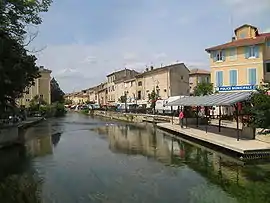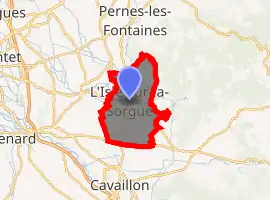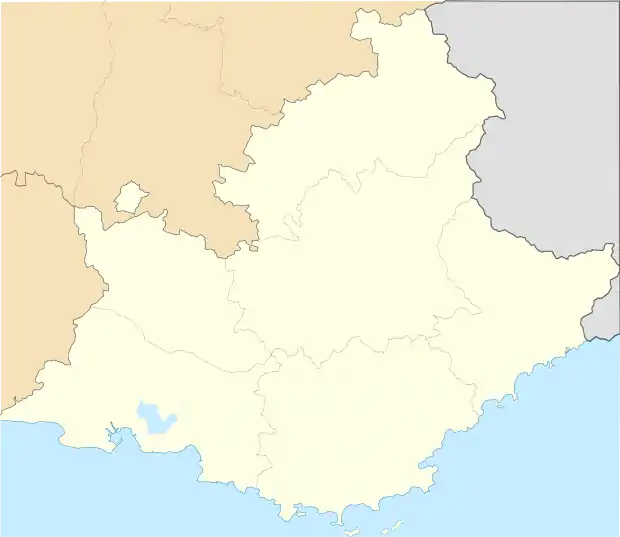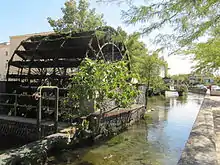L'Isle-sur-la-Sorgue
L'Isle-sur-la-Sorgue (French pronunciation: [lil syʁ la sɔʁɡ]; Occitan: L'Illa de Sòrga [ˈlilɔ de ˈsɔʀɡɔ] or L'Illa de Venissa [ˈlilɔ de veˈnisɔ]) is a town and commune on the Sorgue river in Southeastern France. Politically, the commune is in the arrondissement of Avignon within the department of Vaucluse, in the région of Provence-Alpes-Côte d'Azur.
L'Isle-sur-la-Sorgue
| |
|---|---|
 The village of L'Isle-sur-la-Sorgue, with the river in the foreground | |
.svg.png.webp) Coat of arms | |
Location of L'Isle-sur-la-Sorgue 
| |
 L'Isle-sur-la-Sorgue  L'Isle-sur-la-Sorgue | |
| Coordinates: 43°55′12″N 5°03′18″E | |
| Country | France |
| Region | Provence-Alpes-Côte d'Azur |
| Department | Vaucluse |
| Arrondissement | Avignon |
| Canton | L'Isle-sur-la-Sorgue |
| Intercommunality | Pays des Sorgues et des Monts de Vaucluse |
| Government | |
| • Mayor (2020–2026) | Pierre Gonzalvez[1] (LR) |
| Area 1 | 44.57 km2 (17.21 sq mi) |
| Population (2017-01-01)[2] | 19,421 |
| • Density | 440/km2 (1,100/sq mi) |
| Time zone | UTC+01:00 (CET) |
| • Summer (DST) | UTC+02:00 (CEST) |
| INSEE/Postal code | 84054 /84800 |
| Elevation | 52–246 m (171–807 ft) |
| 1 French Land Register data, which excludes lakes, ponds, glaciers > 1 km2 (0.386 sq mi or 247 acres) and river estuaries. | |
The small town is famous for its many antique shops and hosts antique markets most Sundays. It has many waterside cafés and restaurants, all within walking distance of each other. Its many attractive water wheels throughout the town are still in working order. Keith Floyd, the British TV chef and bon viveur, established a restaurant there during a lengthy sojourn in France.
L'Isle-sur-la-Sorgue had a population of 19,398 as of 2016. It is twinned with the towns of Penicuik in the United Kingdom and Anagni in Italy.
History

Originally known as "Insula", the town officially adopted the name of "L'Isle-sur-la-Sorgue" on 18 August 1890, taking the latter part of its name from the river Sorgue, to which it owed much. As early as the 12th century, the river served defensively as a moat around ramparts which surrounded the town until 1795. The river also served as a source of food and industry: fishing and artisan mills for oil, wheat, silk, paper, woolenry, rugs and dyeing. A busy commerce developed until there were two annual fairs and two weekly markets. The current Sunday open-air market originated on 9 November 1596.
Twins cities
Places to see
See also
References
- "Répertoire national des élus: les maires". data.gouv.fr, Plateforme ouverte des données publiques françaises (in French). 2 December 2020. Retrieved 7 December 2020.
- "Populations légales 2017". INSEE. Retrieved 6 January 2020.
External links
- Official web site of the town (site not available as of 16 April 2015)
- L’isle-sur-la-Sorgues, Capitale de l'antiquité et de la brocante, (in French) Capital of antique shops and flea markets.
| Wikimedia Commons has media related to L'Isle-sur-la-Sorgue. |